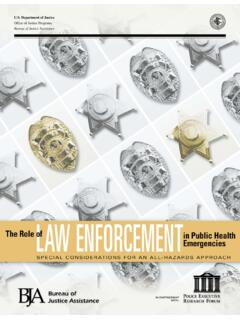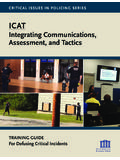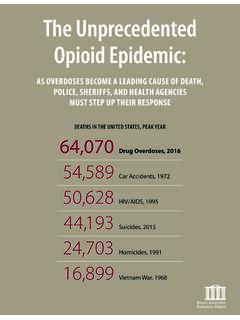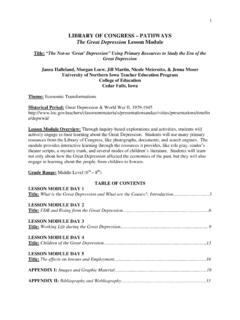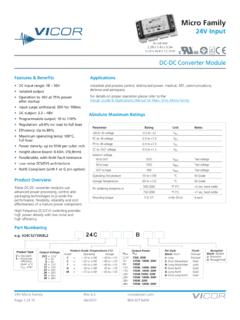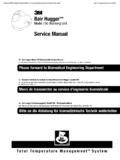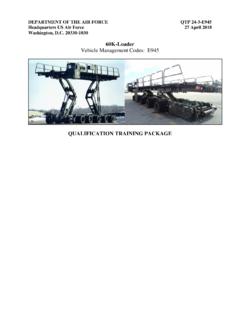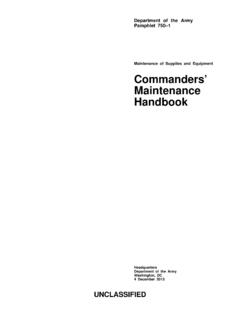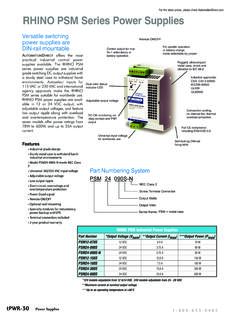Transcription of ICAT Module #2: Critical Decision-Making Model
1 ICAT Module #2: Critical Decision-Making Model Title: Critical Decision-Making Model Recommended Time: 2 hours Primary Audience: Patrol Officers Module Goal: Through classroom instruction and discussion, introduce and explain the Critical Decision-Making Model (CDM) for use by patrol officers in managing Critical incidents, especially those involving subjects who not armed with firearms and who may be experiencing a mental health or other crisis. Required Materials: Digital presentation (Power Point, videos); lesson plan Learning Objectives: At the completion of this course, students will be able to: Describe the key principles of the Critical Decision-Making Model (CDM). Explain each of the five steps of the CDM. Explain the principles of threat assessment, including dynamic risk. Understand and articulate the benefits of the CDM.
2 Use the CDM to describe the actions of a police officer handling a Critical incident, through a video case study. December 2016 Police Executive Research Forum Page 1 of 27. ICAT Module #2: Critical Decision-Making Model Recommended Time Allocation Recommended Time Unit (minutes). 1 CDM overview 10. 2 CDM Core 5. 3 CDM Steps 40. 3a Step 1: Collect Information 3b Step 2: Assess Situation, Threats and Risks 3c Step 3: Consider Police Powers and Agency Policy 3d Step 4: Identify Options and Determine Best Course of Action 3e Step 5: Act, review and Re-assess 4 CDM Uses and Benefits 5. 5 Video Case Study: CDM in Action 25. 6 Learning Activity 1 (CDM Review) 30. 7 Recap and Discussion 5. Total 120. December 2016 Police Executive Research Forum Page 2 of 27. ICAT Module #2: Critical Decision-Making Model Table of Contents I.
3 CDM overview 4. II. CDM Core 5. III. CDM Steps 5. A. Step 1: Collect Information 5. B. Step 2: Assess situation, threat and risks 8. C. Step 3: Consider police powers and agency policy 10. D. Step 4: Identify options, determine best course of action 10. E. Step 5: Act, review and re-assess 12. IV. CDM Uses and Benefits 13. V. Video Case Study: The CDM in Action 15. VI. Learning Activity--1 (CDM Review) 18. VII. Recap and Discussion 18. Appendix I -- Background on PERF's Critical Decision-Making Model 19. Appendix II -- Some Common Offender Risk Behaviors 25. December 2016 Police Executive Research Forum Page 3 of 27. ICAT Module #2: Critical Decision-Making Model I. CDM overview Instructor Notes Recommendation SLIDE #1. One effective way to open this Module is for the instructor to engage the class in a guided discussion that builds the Model from scratch on a chalk- or white-board.
4 Start by asking the class, What guides all of our actions? Answer: values, ethics, mission. Write that in the center on the board (core). Then ask, What's the first thing you do when you get an assignment? Answer: collect information (Step #1). Next ask, Once you get on scene, what do you do? Answer: assess the For background on the CDM, see Appendix I, Also available at situation, threats and risks (Step #2). Continue the discussion for Steps #3, #4 and #5, writing each answer in a circle around the Model core. (pp. 79-87). Conclude by showing Slide #2 and pointing out that the students have, in essence, created the CDM. This approach introduces the CDM in a non-threatening manner and demonstrates that most officers already use it naturally, without slowing down or stopping to check a box. SLIDE #2. A. Introduce CDM.
5 1. It describes a process police officers follow every day a. Puts a name and a flow to that process b. Presents a way to understand and structure your Decision-Making without interfering with your The CDM is similar to the OODA. Loop (Observe, Orient, Decide, Act). ability to act or jeopardizing officer safety used by the military and some police agencies. 2. Why is this valuable? Two reasons: a. Helps you make better decisions up front a Concerns about and benefits of the CDM are covered in more detail reminder to not skip crucial steps in decision- later in this Module (Slides 18-20). making and to continually re-evaluate the situation If students ask, the CDM is based b. Helps you explain your decision later on to on the National Decision Model pioneered in the United Kingdom, supervisors, investigators, in court where it is taught to all police recruits and used in a range of 3.
6 Typical reaction at first: situations. The CDM has been tweaked to better fit with American a. Too complicated policing. For background on UK's b. Will slow me down, won't be able to act if I need to NDM, see: c. Officers will get hurt app-content/national-decision- Model /. d. Just another checklist that officers must follow Some agencies have begun 4. We'll address those issues as we go through adopting the CDM and teaching it to their recruit and veteran officers. a. Keep an open mind For background on use of the b. Think about how you make decisions Model in Nassau County, NY see 5. CDM is a foundation of the entire ICAT approach (pp. 83-84). December 2016 Police Executive Research Forum Page 4 of 27. ICAT Module #2: Critical Decision-Making Model II. CDM Core Instructor Notes A. CDM starts with its core SLIDE #3.
7 1. Your agency's moral compass . 2. Reflects key principles/priorities B. Core is unique to each agency 1. Reflects agency mission, values, vision and ethics This slide reflects the CDM as 2. CDM is a values-based tool -- the core needs to reflect recommended by PERF. Like Nassau those values County, agencies should adjust/. customize the Model and its core to C. Arrows run both directions between core and five steps reflect their mission, values and priorities. 1. Core informs/guides each step ensures officers' actions Here is what Nassau County's are based on agency mission and values decision Model looks like: 2. No step can contradict ethics/values in the core III. CDM Steps 1-5. A. A 5-step Model : 1. Circular not linear process 2. Supports constant re-assessment of situations, threats and risks (based on new information) and re-calibrating of Decision-Making Spinning the Model concept is covered in greater detail on Slide 3.
8 A process known as spinning the Model 17, p. 12. IIIa. Step 1: Collect Information SLIDE #4. A. First step in the Model . 1. But gathering information doesn't stop here it is an ongoing process 2. From the time an officer gets a call all the way through report writing/debrief ( , lessons learned that can be Separating facts from assumptions can make all the difference in applied the next time) effective Decision-Making . Information gathering in the CDM is 3. Continual process of trying to turn assumptions into a way to turn assumptions into facts. facts you can act on assumptions, but always better/safer to act on facts December 2016 Police Executive Research Forum Page 5 of 27. ICAT Module #2: Critical Decision-Making Model B. Ask yourself three key questions Instructor Notes 1. What do I know about subject, victim, and location?
9 2. What further information do I want or need to know? 3. What do my training and experience tell me about this type of incident (lessons learned from past calls)? C. Ask others for information (Dispatch, supervisors, other SLIDE #5. officers, agency computer networks, family members, others on the scene). 1. Ask about this incident a. Who called and what prompted the call? In cases involving persons with b. What do we know about the subject? mental illness, it is especially important for responding officers to c. What is the physical environment? get answers to such questions as: Does the person have a mental d. Are there weapons, children or animals on scene? health condition? e. Are there mental health or substance abuse Is he/she taking medication? Does he/she have a doctor or issues? therapist? The caller, family members, or 2.
10 Ask about previous incidents involving this location/ others on the scene can often provide this information. individuals a. Past arrests? b. Violent behavior, including assaults on officers? c. Past uses of force? D. Gathering information/intelligence is an ongoing process SLIDE #6. 1. If you're not getting information you need keep asking/probing 2. Information collection is the foundation for CDM Steps 2-5. 3. Information collection also continues throughout Steps 2-5. a. You should never be satisfied with the information you have at the moment b. The CDM prompts you to always be thinking about collecting more information December 2016 Police Executive Research Forum Page 6 of 27. ICAT Module #2: Critical Decision-Making Model Reminders Instructor Notes Two reminders prior to showing this and other videos: Set up the video; provide some background information and context.
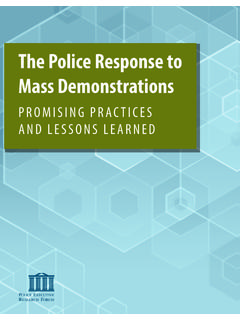
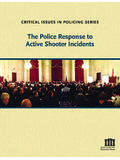
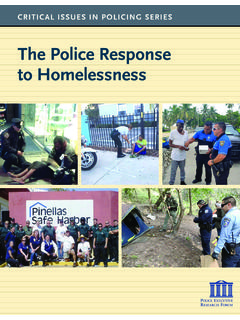

![[Page Intentionally Blank] - Police Executive …](/cache/preview/6/9/5/6/0/0/0/f/thumb-6956000f3f6abdc7d6fe85fa330b8ad5.jpg)
